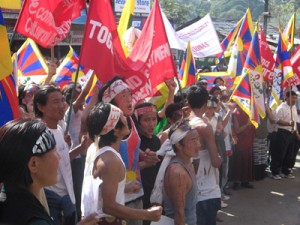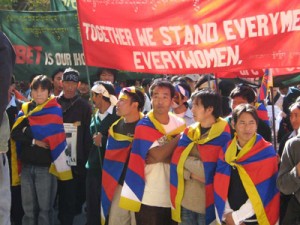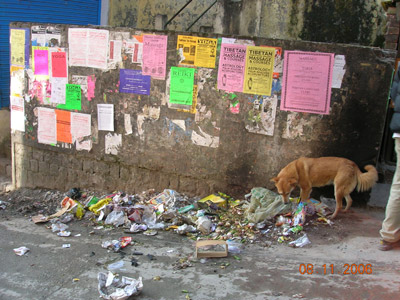 Chinese President Hu Jintao arrived in New Delhi on November 20th for talks on trade with Indian Prime Minister Manmohan Singh and was met with protests in the three cities he visited: New Delhi, Agra and Mumbai. Approximately 200 protestors were arrested during the four day visit.
Chinese President Hu Jintao arrived in New Delhi on November 20th for talks on trade with Indian Prime Minister Manmohan Singh and was met with protests in the three cities he visited: New Delhi, Agra and Mumbai. Approximately 200 protestors were arrested during the four day visit.
The protestors in New Delhi held signs such as “Hu Jintao: Wanted for crimes against humanity in China’s illegal occupation of Tibet”; “Tibetan people want freedom”; “Wake up India” and posters depicting Hu Jintao’s execution methods. Many of the protestors marched through the streets while others participated in a hunger strike.
However, not all of the Tibetans were able to protest where they pleased. Friends of Tibet activist, Tenzin Tsundue, was ordered by the superintendent of police to remain in Dharamsala from November 11th until November 25th. Mr. Tsundue was informed by the superintendent that all protests by Tibetans in New Delhi, Agra and Mumbai would be stopped if he were to leave Dharamsala. He was escorted by police for two weeks to ensure that he did not leave Dharamsala.
This only strengthened many Tibetans’ desire to protest as they boarded buses from Dharamsala for New Delhi.
The emotion was evident throughout the four days and was especially noticeable on November 22nd when the protestors went past the permitted time of 4 pm. The police began arresting people around 7:30 pm while Tibetans and Indian supporters shouted “Free Tibet!” The protestors, except for a 16 year old male, were able to obtain bail around 2.00am the next morning. The minor’s father was contacted and had to make the trip to New Delhi.
noticeable on November 22nd when the protestors went past the permitted time of 4 pm. The police began arresting people around 7:30 pm while Tibetans and Indian supporters shouted “Free Tibet!” The protestors, except for a 16 year old male, were able to obtain bail around 2.00am the next morning. The minor’s father was contacted and had to make the trip to New Delhi.
The Mumbai protests were organized by Tibetan Youth Congress, Friends of Tibet and United Tibetan Association of Maharashtra and Gujarat. This protest included Lhakpa Tsering, the Regional President of Tibetan Youth Congress, setting himself ablaze outside the Taj Hotel just before Hu Jintao’s speech at the India-China Economic, Trade and Investment Cooperation Summit.
The protests were considered a success due to the international media attention and for their nonviolent approach. Stories of the Tibetan protests were present on the BBC, in the Economist and in the American Associated Press. The Indian media also paid due attention. The Times of India offered the following editorial on November 21st :
“Ahead of the Chinese president’s visit, the ministry has gone into overdrive to sanitise New Delhi of Tibetan protestors. First, the police ordered Tenzin Tsundue to stay put in Dharamsala. Now, there are reports of the police asking Tibetan exiles to stay away from the city centre, fearing them to be a security threat. Such gagging of peaceful political protests is inappropriate.”
“The freedom to protest is an essential sign of an open society. India rightfully claims to be one. No government in India is spared of criticism, and the Indian state, in principle, and most often in practice as well, respects the right of citizens to dissent peacefully and demonstrate against official policies. There is no need to make any exception to it even when the target of protest is a visiting head of state.”
Sethu Das, president of Friends of Tibet (India) said: “A small community of Tibetans and their Indian supporters chased the President of China wherever he went. The police were paranoid that Tenzin Tsundue type of protests might be repeated. Hu’s schedules in Mumbai had been changed twice due to security concerns. The Chinese President, one of the most powerful people on earth, was confined to a building for a day fearing protests – this is the power of non-violent actions.”
The protests against the Chinese President’s visit show the power of peaceful protests and offer a format for the upcoming Olympics. These protests were organized in less than a week and received considerable media attention. This only gives hope for the cause of a free Tibet as the Beijing Olympics will have a much larger presence of international media and this opportunity cannot be missed. Just imagine the results that can be achieved at the 2008 Olympics if this much attention can be achieved with less than a week of planning.




 Print
Print Email
Email